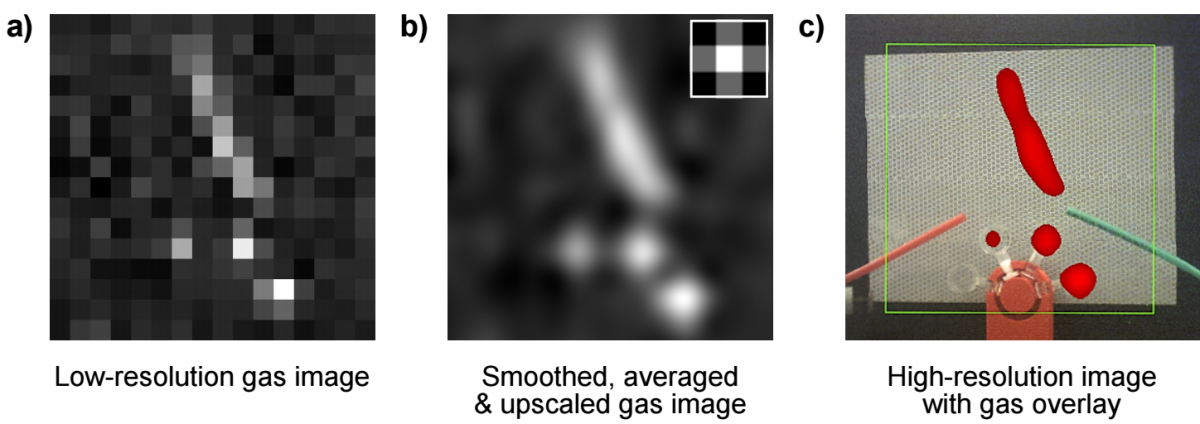Researchers at the University of Glasgow in Scotland have collaborated with laser manufacturer M Squared to develop an infrared hyperspectral imaging system that could one day offer low-cost, real-time detection of methane gas leaks in pipelines and oil and gas facilities. The work was published in Optics Express at the start of the month.

The new system uses real-time infrared hyperspectral imaging to reveal natural gas leaks. Credit (G Gibson et al.)
The new system uses infrared imaging to detect methane, the primary component of natural gas.
‘Despite methane gas being invisible to the eye, we have developed a method of colour-coding this gas information and overlaying it onto a conventional camera image,’ said Dr Graham Gibson who led the technical work at the University of Glasgow. ‘This allows the user operating the camera to look around, identify things and see an overlay of where the gas is present.’
In Optics Express, the researchers have shown that the system can acquire videos of methane gas leaking from a tube at a rate of 0.2 litres per minute and at a distance of one metre. The researchers also demonstrated that their system was sensitive to methane even when other gases were present between the camera and methane.
Commercial methane imaging systems are currently available, but these can be very expensive and don’t work effectively in certain environmental conditions. The new system offers a less-expensive alternative that can detect methane gas at higher sensitivity in a variety of conditions.
‘One of the challenges from a commercial point of view has been translating infrared technology to bigger markets where price points are sensitive,’ said Dr Graeme Malcolm, CEO and co-founder of M Squared. ‘This new technology could allow infrared imaging and sensing to become more readily available and help improve the environment by reducing gas losses in the oil and gas industry.’
The system incorporates hyperspectral imaging technology developed by M Squared and a single-pixel camera developed by the research team in Glasgow. The system detects methane gas by exposing it to a series of infrared light patterns generated by both a laser and a digital micromirror device. The light is absorbed by the gas and an absorption pattern is then reconstructed using the scattered light and compared to the original projected light patterns.
A single-pixel camera was used to measure the scattered light because traditional cameras with millions of pixels are either unavailable or prohibitively expensive in the infrared wavelengths. The single-pixel camera is therefore key to creating an inexpensive methane gas imaging system. In addition, according to the collaboration, the system could be turned into a portable instrument easily as it doesn’t use any scanners or other moving parts.
The imaging system uses active illumination, as in it provides its own light source. This offers multiple advantages over the passive illumination systems currently used in certain gas detectors. Active illumination sources, unlike their passive counterparts, are not affected by environmental changes, such as changes in temperature or light, and also provide enhanced contrast and higher sensitivities.
The researchers now wish to demonstrate their system outside controlled laboratory settings to see how it performs in real-world scenarios. They also want to try the approach with more powerful lasers, which might allow imaging from a greater distance and increase the sensitivity of the gas detection.
‘Using broadly tuneable laser sources rather than the fixed wavelength source used in this paper can extend this method to detection of other hydrocarbons, threat materials such as chemical warfare agents and explosives, and other biologically important substances used in healthcare and diagnostics,’ said Hempler.
Hyperspectral imaging feature articles:

